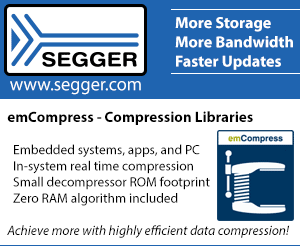
By Jack Ganssle
What a Show
Published 11/27/2002
Wow - what a show!
I just returned from the Embedded Systems Conference (ESC). This Boston venue is the second largest of this show's various locales.
Boston's route 128 area has been famously devastated by the dot com collapse followed by telecom's implosion, so I was frankly worried in the days before arriving in Boston. Daily news of layoffs, scandals, bloated inventories and other tribulations, along with too many heartbreaking tales of unemployed engineers left me wondering if anyone would attend. Worse, being located at the huge Hynes Convention center I wondered if a possibly-shrunken show would be swallowed in those great halls.
Yet the embedded fraternity turned out, in numbers I'm told that greatly exceeded the sponsor's expectations. Vendors abounded, with an array of dazzling offerings.
What was cool there? How about the pool ace who gave a Tensilica patter while wowing the audience with trick shots? How about the fact that Tensilica can put literally hundreds of processors on a single IC? (Me, I'm left cold by the pool but was wowed by the thought of so many CPUs on a single die).
Zilog was back, with their eZ80 processor which extends the venerable Z80's architecture into the 2000s. In my youth I grew to love the Z80. It was the first micro that needed a single-phase clock and just one power supply. The eZ80 somehow extends its ancestor's address space to a linear 16 Mb, runs to 50 MHz, and now hosts TCP/IP protocol stacks. When you consider that the 8051 is still in massive use, the 68HC05 sells like hotcakes, and 68k derivatives drive uncountable embedded products, it seems that old processors never die.
Rabbit Semiconductor's Rabbit 3000 is another Z80 heir, theirs deriving more from the very popular Z180. The 3000 also runs really fast and does lots of cool things. Most fascinating to me was to learn that many of the company's customers buy the processors on a board with memory and other support circuitry. In some cases even in volumes of tens of thousands of units per year. The sub-$50 price tag of these modules is pretty hard to beat, especially when one considers the real amortized cost of engineering a PCB. Need a small but smart sensor somewhere? They offer modules with Ethernet and TCP/IP. We've long dreamed of the "software IC", a packaged bit of code sold much like distributors sell chips. Perhaps the future lies in a morph between hardware and software; maybe we'll buy entire modules that implement specific functions.
Ever yearn for one of Star Trek's Universal Translators? Well, that technology isn't quite here, but I did have a chance to play with ADS's Phraselator. It looks like a ruggedized PDA. Speak into the mike and it displays your phrase on the LCD screen. If you agree with its interpretation, it'll speak your words in Urdu, the language of Afghanistan. The vendor claims they produced the unit in just four months. Me, the ever-hopeful peacenik, sees this as another way to break down communications barriers in troubled parts of the world.
One new trend was the great number of contract engineering houses who had booths. Past shows rarely had more than one or two; Boston sported maybe a dozen. Managers are telling me that they are reluctant to hire developers, so have started turning more to outside contractors for their engineering efforts. It's less costly to hire consultants, and much easier to replace them when things aren't going well. The contractors tell me that 2002 started rocky but in the past few months most have seen significant improvements in their businesses.
I was most fascinated, though, to hear from so many vendors that the attendees were serious prospects. Many were looking for solutions to their current development problems. Tirekickers were in the minority.
The conference organizers told me that attendance at the various classes (for which there's a non-trivial charge) was nearly double expectations. I don't know the numbers, but my classes were packed.
So, companies are sending engineers to the shows; they're willing to spend money on classes and training, developers are clearly shopping for help with current projects, and even the Dow has shown signs of life, with 7 consecutive up weeks.
Let's hope the success of this conference is a harbinger of hope for our industry.



